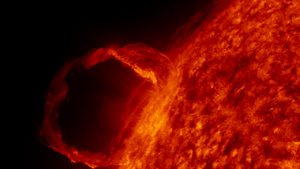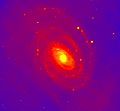First light (astronomy) facts for kids
In astronomy, first light means the very first time a telescope is used to look at the Universe. It's a big moment! This is different from the first light of the universe itself, which refers to the light from the very first stars.
Contents
What is Telescope First Light?
When a new telescope is finished, "first light" is when it takes its first picture of space. This is usually not the very first time the telescope has been used. Engineers will have already done many tests during the day to make sure everything works.
The pictures taken during first light are often not perfect. This is because the telescope's parts have not yet been fully adjusted. Scientists usually choose a well-known and amazing astronomical object for this special first picture. First light is always a very exciting time for everyone involved. This includes the people who designed and built the telescope. It's also exciting for the whole astronomy community.
Famous Telescope First Lights
The 200-inch Hale Telescope had its first light on January 26, 1949. It looked at a nebula in the constellation Monoceros. This was done under the guidance of American astronomer Edwin Hubble. The image was so important that it was printed in many magazines.
The Large Binocular Telescope had its first light on October 12, 2005. It used one of its main mirrors to view NGC 891. This is a spiral galaxy in the Andromeda constellation. The second mirror was added in January 2006. The telescope was fully ready to work by January 2008.
First Light of the Universe
In physical cosmology, "first light" means the light from the very first generation of stars. These first stars were super big and bright. They formed less than a billion years after the Big Bang. Their light ended a period called the "cosmological Dark Ages." Before these stars, the universe was dark and filled with gas.
Images for kids
-
Very Large Telescope's wide field imager VIMOS takes its first light image of NGC 5364.
-
Hubble Space Telescope's first light with its impaired WFPC, 1990
-
First light of the Tarantula Nebula by TRAPPIST
-
First light of WISPR on the Parker Solar Probe, September 2018
See also
 In Spanish: Primera luz para niños
In Spanish: Primera luz para niños







